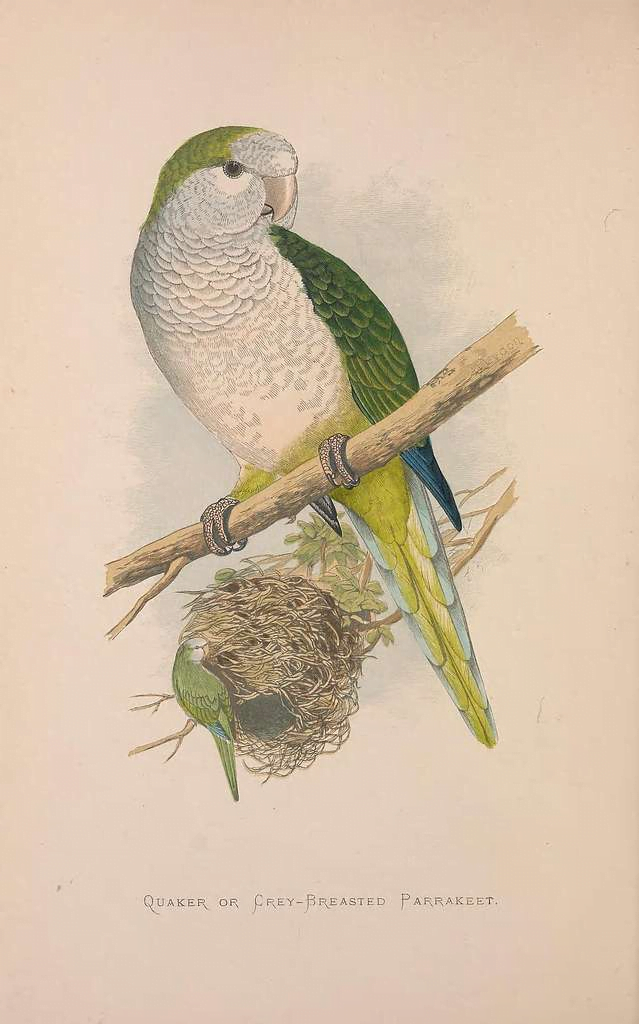Quaker parrots, also known as monk parakeets, stand out in the avian community not just for their striking green plumage but for their exceptional social skills and ability to mimic human speech. Unlike the more reserved or solitary bird species you might be familiar with, these lively creatures bring a unique blend of companionship and entertainment to their human counterparts.
They’re a bundle of energy and affection wrapped in feathers, challenging the stereotype of birds being mere background pets. If you’re venturing into the world of pet ownership or looking to add a feathered friend to your family, understanding the vibrant personality and care needs of quaker parrots could turn your decision into an adventure filled with chatter, bonding, and unexpected joy.
Key Takeaways
- Quaker parrots, also known as monk parakeets, are social, intelligent birds that require a lot of interaction and stimulation. Engage with them daily to keep them happy and healthy.
- These birds have a unique ability to mimic human speech, making them entertaining companions. Encourage vocalization through regular, gentle communication.
- Proper health care for a Quaker parrot includes regular vet check-ups and a balanced diet rich in fruits, vegetables, and appropriate bird pellets.
- Creating a safe and comfortable living environment is crucial. Ensure their cage is spacious enough for them to stretch their wings and move around freely.
- Quaker parrots thrive on routine and structure. Establish a daily schedule for feeding, playtime, and rest to help them feel secure.
- Be mindful of the legal status of Quaker parrots in your area, as they are considered invasive in some regions. Always research local wildlife regulations before deciding to bring one into your home.
Breed Overview
History
The monk parakeet, first documented by Georges-Louis Leclerc in 1780, has a rich history. Initially classified as Psittacus monachus, its scientific name later changed to Myiopsitta monachus. This shift marked a significant moment in understanding these birds.
They have spread far from their South American roots. Today, they are found worldwide, often labeled as invasive in new territories. Their adaptability has allowed them to thrive in diverse environments.
Physical Characteristics
Monk parakeets showcase bright-green plumage and a greyish breast, making them stand out among other birds. The size difference between genders is notable; females tend to be slightly smaller than males.
These birds are known for their longevity, living 20–30 years. This trait highlights their resilience and adaptability across various environments.
Personality and Temperament
Monk parakeets are highly social creatures. They form large, noisy flocks that reflect their communal nature. Their intelligence is remarkable, with many able to mimic human speech. This ability makes them sought-after pets.
However, they can become territorial during the breeding season. This sometimes leads to aggression, posing challenges for those unprepared for such behavior.
Health And Care
Common Health Issues
Monk parakeets can catch psittacosis, also known as parrot fever. This disease poses a risk to both birds and humans. Owners should be aware of this potential health threat. Symptoms in birds include lethargy and respiratory problems.
Obesity is another concern for these parrots. A diet high in fat leads to weight issues. Regular vet visits are crucial. They help catch signs of feather plucking and breathing troubles early.
Dietary Needs
A balanced diet keeps monk parakeets healthy. Seeds, fruits, veggies, and pellets should make up their meals. Chocolate, avocado, and sugary foods are harmful to them. These items can cause severe health issues.
Fresh water is a must every day. Sometimes, vets suggest adding supplements to their diet. But always seek professional advice before doing so.
Exercise Requirements
Monk parakeets need daily time outside their cages to fly and play. This activity is vital for their physical and mental well-being. Owners should create a safe space for them to move freely without dangers.
Interactive toys and puzzles offer much-needed mental stimulation. They prevent boredom and encourage physical activity.
Grooming
Wing clipping prevents escapes or injuries at home. It’s a safety measure that helps keep your bird safe indoors.
Nails grow fast on these birds, requiring regular trims to avoid problems related to overgrowth. Baths or showers are essential too, keeping their feathers in good condition.
Living with a Quaker Parrot
Training and Socialization
Early socialization is crucial for quaker parrots, also known as monk parakeets. It prevents them from developing aggressive tendencies. Positive reinforcement techniques work best for training these intelligent birds. Rewards like treats or verbal praises encourage good behavior.
Quaker parrots have a remarkable ability to learn tricks and mimic speech. This makes their social interaction fun and engaging. Regular training sessions strengthen the bond between the bird and its owner.
Environment
A spacious cage is essential for a quaker parrot’s well-being. It should have ample room for toys, perches, and movement. The environment must be safe and stimulating to keep the bird happy and healthy.
Access to natural sunlight benefits their health but place their cage away from drafty areas or direct sunlight. Extreme temperatures can cause health issues in these sensitive birds.
Activities They Enjoy
Quaker parrots thrive on mental stimulation. Puzzle toys and foraging activities are great ways to keep their minds sharp. These birds enjoy interacting with humans or other birds, which fulfills their social needs.
For those who can, setting up a bird-safe outdoor enclosure offers fresh air and natural sunlight exposure. This setup mimics their natural habitat and provides a change of scenery.
Misc.
Popular Names
Choosing the right name for a monk parakeet is both an art and a science. Common names like Kiwi, Buddy, and Sky often reflect their vibrant personalities and colorful appearances. It’s wise to pick a name that mirrors their playful and affectionate nature. For a touch of creativity, consider naming them after famous parrots or based on unique characteristics they exhibit. This process adds fun to the bonding experience with these delightful birds.
Pet owners sometimes draw inspiration from the parrot’s antics or favorite toys when selecting a name. This personalizes the naming process, making it more meaningful.
Fun Facts
Monk parakeets stand out for their extraordinary nesting behavior. They are known for constructing large communal nests that can accommodate multiple families. This trait makes them unique among parrot species, as they are the only ones to build stick nests in trees or on man-made structures.
These birds have shown remarkable adaptability to urban environments. Their intelligence and resilience shine through as they navigate life in cities far from their native habitats in South America. Stories of monk parakeets thriving in the United States highlight their ability to overcome challenges and coexist with humans.
Common Myths
Contrary to popular belief, monk parakeets are not silent companions; they can be quite vocal. This misconception often leads to surprises for new pet owners expecting a quiet bird. Similarly, while some believe these parrots are aggressive, proper socialization reveals their friendly demeanor.
Another myth is that monk parakeets require minimal care. In reality, they crave attention, socialization, and mental stimulation to stay happy and healthy. Understanding these needs is crucial for anyone considering adding a monk parakeet to their family.
Most Similar Breed
The cliff parakeet often comes up in discussions about birds similar to the monk parakeet. Both share commonalities in habitat preferences and social behaviors but differ significantly in appearance and nesting habits.
Within the broader Psittacidae family, these birds relate closely to other small parrot breeds such as Lovebirds or Cockatiels. These species also demand similar levels of care, social interaction, and mental engagement from their owners. For potential pet owners looking for alternatives but desiring comparable experiences, exploring these related breeds could be beneficial.
Closing Thoughts
Living with a Quaker parrot is a journey filled with chatter, companionship, and a bit of mischief. You’ve learned about their care needs, health concerns, and the unique quirks that make them such fascinating companions. These birds aren’t just pets; they’re feathered friends who’ll share your home with personality and panache. Remember, the key to a happy Quaker parrot lies in understanding and meeting their needs—something you’re now well-equipped to do.
hat’s next? Dive into the world of Quaker parrots with both feet. Whether you’re pondering the idea of bringing one home or looking to deepen your bond with your feathered friend, there’s always more to learn and discover. Share your stories, join communities of fellow parrot enthusiasts, and never stop exploring the vibrant world these incredible birds offer. Your adventure with a Quaker parrot is just beginning.
Frequently Asked Questions
How long do Quaker parrots typically live?
Quaker parrots can live up to 20-30 years with proper care. It’s a long-term commitment, kind of like marrying your feathered friend!
What do Quaker parrots eat?
They love a varied diet: think seeds, fruits, veggies, and pellets. It’s like they’re foodies, but with feathers.
Can Quaker parrots talk?
Absolutely! Quaker parrots are quite the chatterboxes. With patience and practice, they can mimic words and sounds. It’s like having a tiny, feathery impersonator at home.
Do Quaker parrots need a lot of space?
Yes, they do. Imagine being cooped up in a tiny room all day; you’d get stir-crazy too! A spacious cage and regular out-of-cage time are musts for these active birds.
How often should I take my Quaker parrot to the vet?
A yearly check-up is recommended. Think of it as their annual physical. Prevention is better than cure!
Are Quaker parrots good for families?
They sure are! Quaker parrots are social and bond well with their human flock. Just remember, every bird has its own personality—like people but with beaks.
Is it hard to train a Quaker parrot?
Not at all! With consistency and positive reinforcement (treats work wonders), training your Quaker can be a fun bonding experience. It’s like teaching your feathered friend some cool party tricks.


 Creator: Jim Lynch
Creator: Jim Lynch 




0 Comments